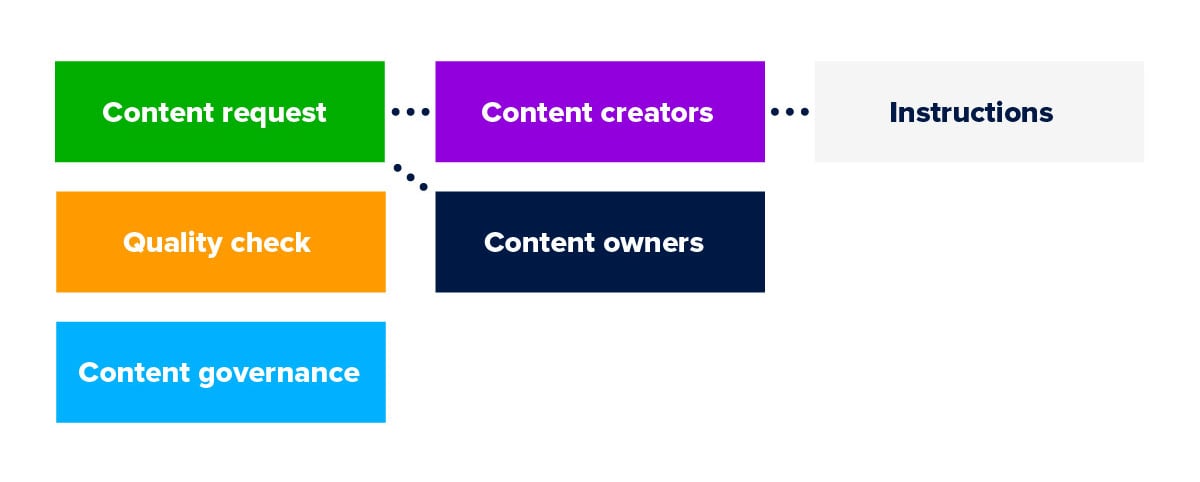Have you recently built or adjusted your content processes? Are you planning to change how your colleagues work to optimize the team’s productivity and scale content production?
If you've answered yes, you’ve probably battled with questions about how to introduce the change to the company best and make your coworkers and stakeholders excited about it.
Before starting to think about how to communicate and educate, you need to focus on documenting the process. From asking “why we are doing this?” to providing concrete instructions and steps that main stakeholders need to take, everything should be recorded, broken down into parts in a logical order, and stored in a location that’s easily accessible.
Why is documentation essential?
Documenting everything may sound like some work, and in all honesty, it is. Still, it’s crucial to ensure a new process operates effectively and that the change is carried out correctly at your company.
Limited (or non-existent) documentation can be a big problem when scaling content creation. How can you empower more colleagues and future hires to make use of a process if they’re wholly dependent on you to carry it out successfully?
The main goal of documentation and communication is for everyone involved in the new process to familiarize themselves with the latest practices, adopt (and advocate) them, and find help easily, whenever needed.
Even if you work in a small team or are a one-person show, make sure to have everything well documented and stored in a shared location. You’ll thank yourself one day.
What, why, and how
An excellent approach to communicating the change is establishing what, why, and how. This helps your colleagues and stakeholders better understand the change and adopt the new process.
Let’s have a closer look at the three parts of this approach.
What
What is actually happening? Communicate the concrete changes that are being introduced and their impact on stakeholders’ work.
For example: “We’re introducing a new workflow for our marketing content creation.”
Why
Why these new processes, additions, or changes are necessary, and how they will benefit everyone. Setting up content operations is often playing a long game. Processes are built to support content creation and make it more efficient and scalable in the long run.
Often right after a change is introduced, it may seem that a new practice takes more time, and your colleagues don’t experience the positive impact right away. Therefore, making your case and communicating “why” is crucial from the very beginning.
It’s helpful to share the goal of the new process and compare it to the current situation. This way, you can emphasize the importance of the change.
For example: “Our current content governance model isn’t structured enough to secure consistency and quality. The new framework will help us scale content creation while keeping all our content up-to-date, relevant, and organized.”
How
Guidelines, instructions, and training materials — the “how” includes all the concrete steps the stakeholders need to take to carry out the new process. You can start by creating an overview or a list of the main changes and sharing it with the individuals involved.
For example: “Follow these steps to submit a content request."
How to make process documentation logical
One of the main struggles I’ve come across around documentation is the editing part. How do I clip and crop and break all this recorded information into concise pieces that cover everything without being overwhelming or irrelevant to the reader?
Let’s divide the information into segments. For instance, you can use different stakeholders or steps of a workflow as categories and create summaries and bespoke instructions for these specific groups and cases (see an example below). This is great for targeting the right audience with the content they need. And, hey, it’s pretty handy for organizing your thoughts.

Everyone involved must go through all the documentation and guidelines, but flooding your colleagues with information might not be the way to go. Lack of time and limited focus span often lead to unopened documents and unread paragraphs.
Therefore, having guidelines, strategy documents, and instructions conveniently available throughout the actual process enforces the guidelines and prevents mistakes.
When I introduced the new content creation workflow here at Foleon, I attached instructions (general and case-related) and brand principles to the different workflow steps. This doesn’t only make the documentation easily accessible but also the process itself more structured. And it’s a real-time-saver from the user’s side.
Have documentation at hand
Make sure that the structure of the asset library that you use is as logical and straightforward as possible.
When it comes to governing the documentation, I recommend having all assets located centrally in one place. For example, if you use Google Drive, it’s good to have all the instructional materials and strategic documents within one parent folder, easily accessible to everyone who needs them. Again, you can have separate folders for different stakeholders, stages, or tools used in the process.
If your company has a resource hub, it’s good to add a direct link to the documentation or a folder where it’s located.
Creative ways to grab your colleagues’ attention
Once you’ve recorded everything, summarized it, organized it, and placed it in a shared location, it’s time to share it with the world (your company).
Going through documents, slides, and guides is usually quite dull. So, why not make it fun? Learning through play is effective so try to develop creative ways to educate your team.
Here are some things to consider:
Play around with tone of voice
Instead of being dry and overly formal, try more fun ways of communicating. Weave the what, why, and how into a story that engages the reader. This makes the reading experience more pleasant and helps the reader remember your text better.
Use visuals and infographics
Visuals and graphics are great because they break the text, making the content less text-heavy and more appealing to the reader. They also help with learning and creating connections between different elements. For instance, an infographic can give an overview of a process or its structure at a glance — impactful and visually pleasing.
Create video tutorials
“Hi everyone, welcome to today’s tutorial.” Who doesn’t love that? Video is a great way to engage your audience and strengthen your role as the process owner. If you have the skills and resources, throw in some graphics and visuals or make it fully interactive and ask the viewer to join in and try the process as you go.
Throw workshops and training sessions
A face-to-face session is possibly the most effective way to train your colleagues on a new process. Putting together a workshop or a Q&A type of training session is great for bringing clarity around the change and getting everyone involved.
The required preparation by the participants depends on the scope of the change and the amount of material. It’s wise to ask the trainees to review the materials beforehand and come bearing questions. On the contrary, if the resources allow and you prefer explaining everything yourself, you can take a “tabula rasa” (blank slate) approach by starting from zero.
Summary
Clear, accessible documentation empowers stakeholders to use new processes and adopt and advocate them. It also prevents content bottlenecks and mistakes from happening. Especially if your goal is to scale content creation, you need to ensure that the process documentation is done well.
Have documentation stored logically and centrally, for example, in a Google Drive folder or a resource hub. Keep the communication open with stakeholders, actively optimize the processes and update the documentation, such as instructions and guidelines.
Effectively communicating the process and its documents can be challenging, but you can try creative ways to reach and educate stakeholders. Play around with the tone of voice, use visuals and graphics, create a story or try video tutorials and workshops.
It’s essential to document everything about the process and communicate it well. This way, you can empower more colleagues to use it in their everyday work and scale content creation effectively.


.png)
